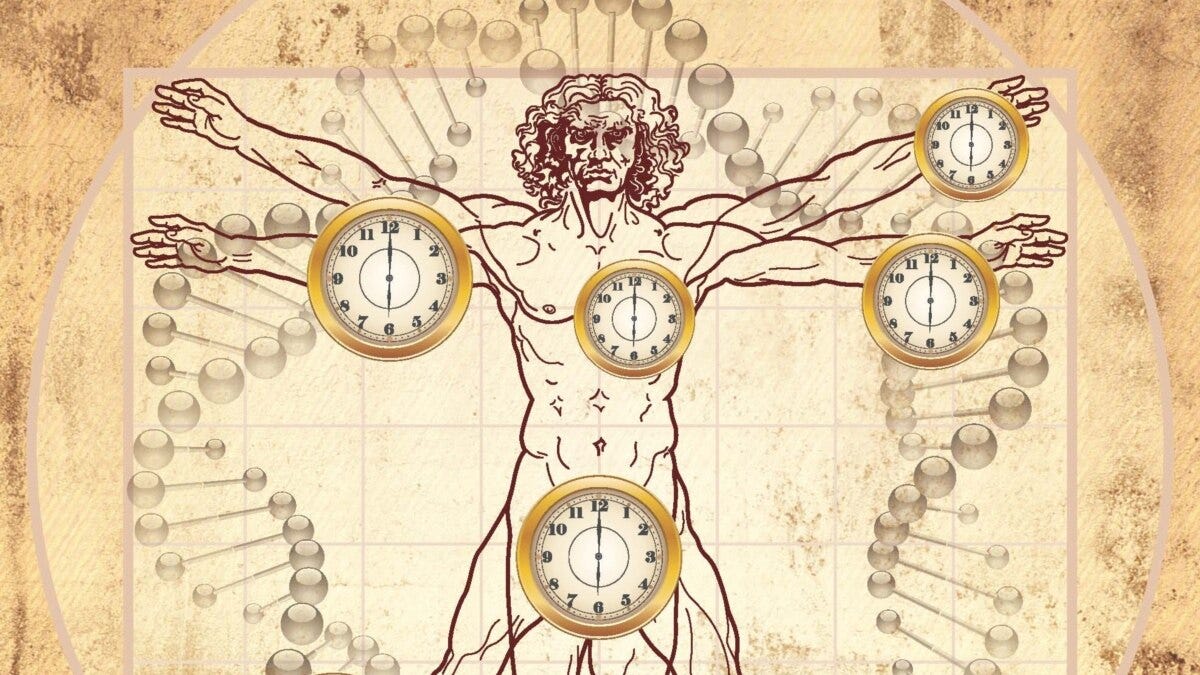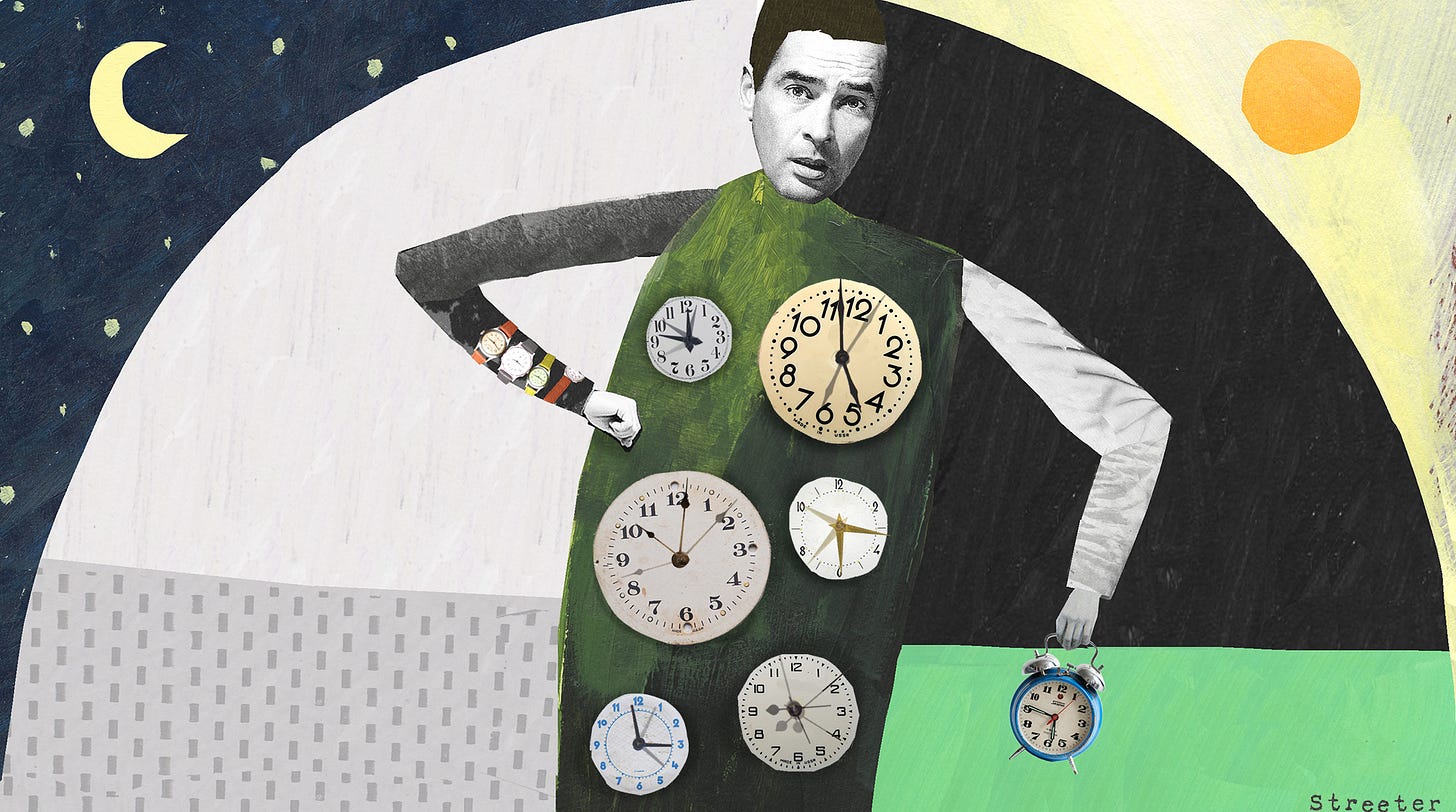Circadian Rhythm Disruption maybe the most invasive environmental toxin in our modern world.
From the dawn of humanity light has shaped our lives. Though mostly an ignored backdrop to our everyday stressors, this often neglected aspect of biology maybe the cause for some of today’s most alarming chronic diseases.
The circadian rhythm, often referred to as the body’s internal clock, plays a critical role in regulating sleep-wake cycles and overall physiological processes (which I’ve written about before at depth). In this newsletter and video we will explore what are causing these disruptions and practical steps you can take to correct and align your circadian rhythm for better health.
What Is Circadian Rhythm Disruption?
Circadian rhythms are 24-hour cycles that help regulate sleep, feeding behaviors, hormone release, and body temperature. These rhythms are influenced by environmental cues, most notably light. Circadian rhythm disruption occurs when there is a misalignment between your internal clock and the external environment, often as a result of lifestyle factors such as irregular sleep schedules, shift work, or prolonged exposure to artificial lighting.
A study by Zimmet et al. (2021) from the National Center for Biotechnology Information (NCBI) underscores the role circadian rhythms play in the body’s metabolic and physiological functions. Disruptions to these rhythms have been shown to cause severe stress on the body, leading to a range of chronic health conditions, including obesity, diabetes, cardiovascular disease, and even cancer. (Zimmet PZ, et al. “Disruption of Circadian Rhythms.” JCI, 2021.)
Why Circadian Rhythms Are Essential for Human Health
The circadian system regulates not just sleep but a host of other biological processes, from immune function to digestion. For example, circadian clocks within cells help ensure that various physiological processes operate harmoniously with the body’s daily energy cycles. This system relies heavily on the synchronization between external environmental cues, particularly light, and the internal biological clocks present in virtually every cell of the human body.
Studies show that when circadian rhythms are chronically disrupted, it can weaken immune responses, promote inflammation, and impair cognitive functioning. This has a cascading effect on human health, eventually leading to diseases like hypertension, metabolic syndrome, and certain cancers. One key study shows that circadian rhythm disruption impairs glucose metabolism, which can increase the risk of developing type 2 diabetes over time. (Johnston JD, et al. "Impact of Circadian Rhythms on Glucose Regulation." Nature Reviews Endocrinology, 2019.)
Modern Lighting, Screens, and Indoor Lifestyles: Catalysts for Circadian Disruption
In our modern world, the primary disruptors of the circadian rhythm include artificial lighting, screen technology, and the largely indoor lifestyles that many people have adopted. The blue light emitted by screens on smartphones, tablets, and computers mimics daylight. This artificial light exposure, especially during the evening and night, confuses the brain into thinking it is still daytime, delaying the release of melatonin—a hormone critical for inducing sleep and regulating the sleep-wake cycle.
Before the advent of artificial lighting, humans were predominantly exposed to natural light during the day and darkness during the night, in sync with their internal clocks. Today, however, prolonged exposure to bright lights during night-time hours is causing widespread circadian misalignment. Research from Harvard Medical School indicates that even a few nights of poor light exposure can disrupt circadian rhythms enough to influence metabolic function and sleep quality. (Czeisler CA, et al. "Impact of Light Exposure on Circadian Rhythms." Harvard Medical Journal, 2020.)
Melatonin and Its Vital Role in Human Health
Melatonin is a hormone produced by the pineal gland in response to darkness. It signals to the body that it’s time to sleep, helping to regulate sleep patterns and maintain the circadian rhythm. Disruptions to this process—whether due to exposure to artificial lighting or irregular sleep schedules—can reduce melatonin production, making it difficult to fall asleep and stay asleep.
More than just aiding sleep, melatonin is known for its powerful antioxidant properties, playing a role in reducing oxidative stress and inflammation in the body. Inadequate melatonin production has been linked to a range of chronic conditions, including depression, cardiovascular disease, and certain cancers, particularly breast and prostate cancer, both of which have shown associations with circadian rhythm disruption. A study by Walker et al. (2018) emphasizes that melatonin is critical not only for sleep but also for maintaining the overall balance of hormonal cycles in the body. (Walker MP, et al. "Melatonin: An Antioxidant and Circadian Regulator." Journal of Sleep Research, 2018.)
The Impact of Modern Technology on Melatonin
One of the key factors in circadian disruption is the widespread use of technology, especially before bedtime. Screens emit a large amount of blue light, which suppresses the production of melatonin and causes delayed sleep onset. Research indicates that even brief exposure to blue light from screens can delay melatonin release by up to 90 minutes, pushing the body’s circadian rhythms into disarray. Prolonged suppression of melatonin not only affects sleep but also impairs the immune system, exacerbates stress, and may increase the risk of developing chronic diseases like diabetes and heart disease.
Action Steps to Correct Circadian Rhythm Disruption
While modern life makes circadian rhythm disruptions almost unavoidable, there are several actionable steps you can take to realign your internal clock and protect your health:
Limit Blue Light Exposure: Avoid screens, especially smartphones and computers, at least one hour before bedtime. Consider using blue light-blocking glasses or filters to minimize exposure during the evening.
Download Programs like IRIS or FLUX to mitigate flicker/blue light especially after dark
Wear blue blockers (like these) after dark
Create a Consistent Sleep Schedule: Go to bed and wake up at the same time every day, even on weekends. Consistency helps reset the body’s internal clock and supports better sleep quality.
Expose Yourself to Natural Light: Spend time outdoors during the day, especially in the morning. Natural light exposure early in the day can help regulate your circadian rhythm and improve sleep patterns at night.
Dim Indoor Lights in the Evening: Reduce exposure to bright lights after sunset by dimming indoor lights or using warmer, low-light settings. This helps signal to your brain that it’s time to wind down.
Invest in circadian friendly lighting like what I use HERE (save 15% with code RMB15)
Join The Circadian Rhythm Disruption Challenge
I’m excited to be an ambassador for The CRD Challenge, a free, 21-day bite-sized educational experience designed to teach people how to realign to nature’s rhythms and empower them to take back control over the destiny of their health and happiness. It is comprised of step-by-step educational materials, co-written by a team of circadian health experts, that are delivered via a free Skool community through a variety of formats (video, audio and written content) to best suit the learning style of those participating.
Each step of the challenge takes users on a journey to evolve their understanding of how circadian rhythms influence human health and how key zeitgebers such as light, chrono-nutrition and electromagnetic fields entrain these rhythms, with the ultimate aim to create and embed vital lifestyle habits that can enable individuals and their communities to experience a life lived in rhythm.
The timeline and description of the specific content delivered will only be revealed as the challenge unfolds. The purpose of this is to pique curiosity and encourage continued commitment to the 21-day process, thereby helping participants to develop first-hand experience of how simple, gradual and consistent circadian health practices can transform their lives and those of their families and communities.
Hope to see you there,
Ryan













Share this post